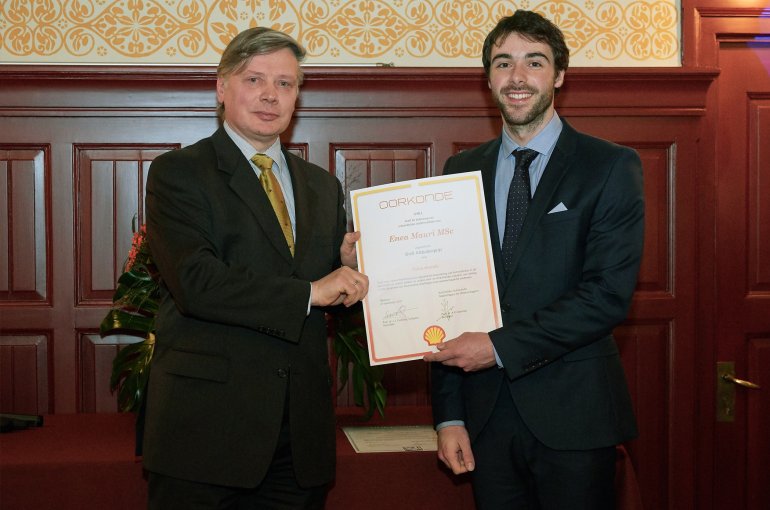‘Mature physicist who stands head and shoulders above the rest’
Shell Physics Graduation Prize for Enea Mauri

The Master’s thesis written by Enea Mauri has been crowned with a Shell Graduation Prize for Physics. According to the jury, Mauri’s excellent understanding of the underlying physics marked him as a ‘mature physicist’, who stands head and shoulders above what can be expected of a Master’s student. Mauri studied Theoretical Physics, and graduated on his research into high-temperature superconductors. To do so, he used a holographic model of black holes that was influenced by ideas posited by Utrecht’s Nobel Prize winner Gerard ‘t Hooft.
The walls of his office at the university are covered with equations. “We don’t do practical experiments”, says Mauri (25). “Our experiments involved calculations using a variety of models.” No superconductors can be seen in his office, and he has never looked at a black hole. His research is entirely done on computers and paper.
Still no working theory
Mauri uses formulas to study superconductors at relatively high temperatures. “The mechanism of superconductivity at temperatures around absolute zero are well-understood, but we still don’t have a working theory that explains superconductivity at higher temperatures. That’s why we study it”, Mauri explains. So far, -138 degrees Celsius is the highest temperature at which a material has been observed to be superconductive.
Open pipe with water
But what is superconductivity, exactly? “Imagine a horizontal pipe full of water”, posits Mauri. “When you lift up one end of the pipe, the water starts to flow to the other end, and it stops flowing when you lay it horizontal again. That’s due to the friction. But if we took away the friction, then the water would continue to flow, even if the pipe was horizontal. The same applies to a superconductor”, he explains. “If I connect it to voltage, then it carries a current, but when I remove the potential difference, the current keeps running.”
Black holes
At higher temperatures, the particles in the superconductive material have a large number of interactions, which makes them difficult to study. Mauri therefore aims to better understand these interactions using a holographic model for describing black holes and elementary particles. The model allows him to study a virtual black hole using Einstein’s theory of gravity. “Because the physics of bent space-time can also be applied to metals”, Mauri explains, “and therefore also to superconductors.”
Much interest in high-temperature superconductors
“There is a lot of interest in high-temperature superconductors around the world”, says Henk Stoof, Professor of Theoretical Physics and Mauri’s supervisor for his Master’s thesis. “A superconductor can carry an electric current without resistance, so there is no loss of energy. That saves you a lot of money on your electric bill. Unfortunately, superconductors have a critical temperature, and they only become superconductive under that temperature. “What we need is a material in which the critical temperature is close to room temperature. Then we wouldn’t have to cool the superconductor to such extremes.”
One of the very best students
Stoof is overjoyed at Mauri’s Shell Thesis Prize, especially because his was one of the three best in any field of Physics, not just in Theoretical Physics. “Enea is one of the very best students whom I’ve ever had the privilege of supervising, and he absolutely deserves the Shell Prize.” Stoof is also pleased to be able to supervise Mauri’s PhD research as well. His continuing research will mainly focus on ‘strange metals’ that belong to a family of high-temperature superconductors.
Recognition
The award includes a cash prize of € 5,000. Mauri will probably use the money to attend a Summer School course. “I’m glad that Shell organises this award contest. It’s a recognition of the importance of our field of study. And of course, Shell would benefit from a more efficient transport of energy”, he laughs. He was presented with the Graduation Award on 27 November at the Koninklijke Hollandsche Maatschappij der Wetenschappen (KHMW) in Haarlem.
text: Roy Keeris

